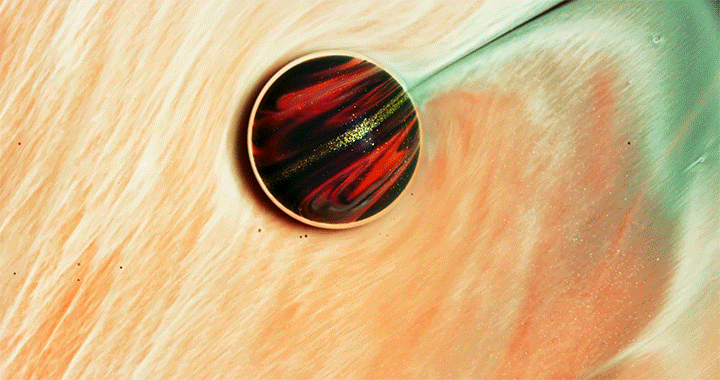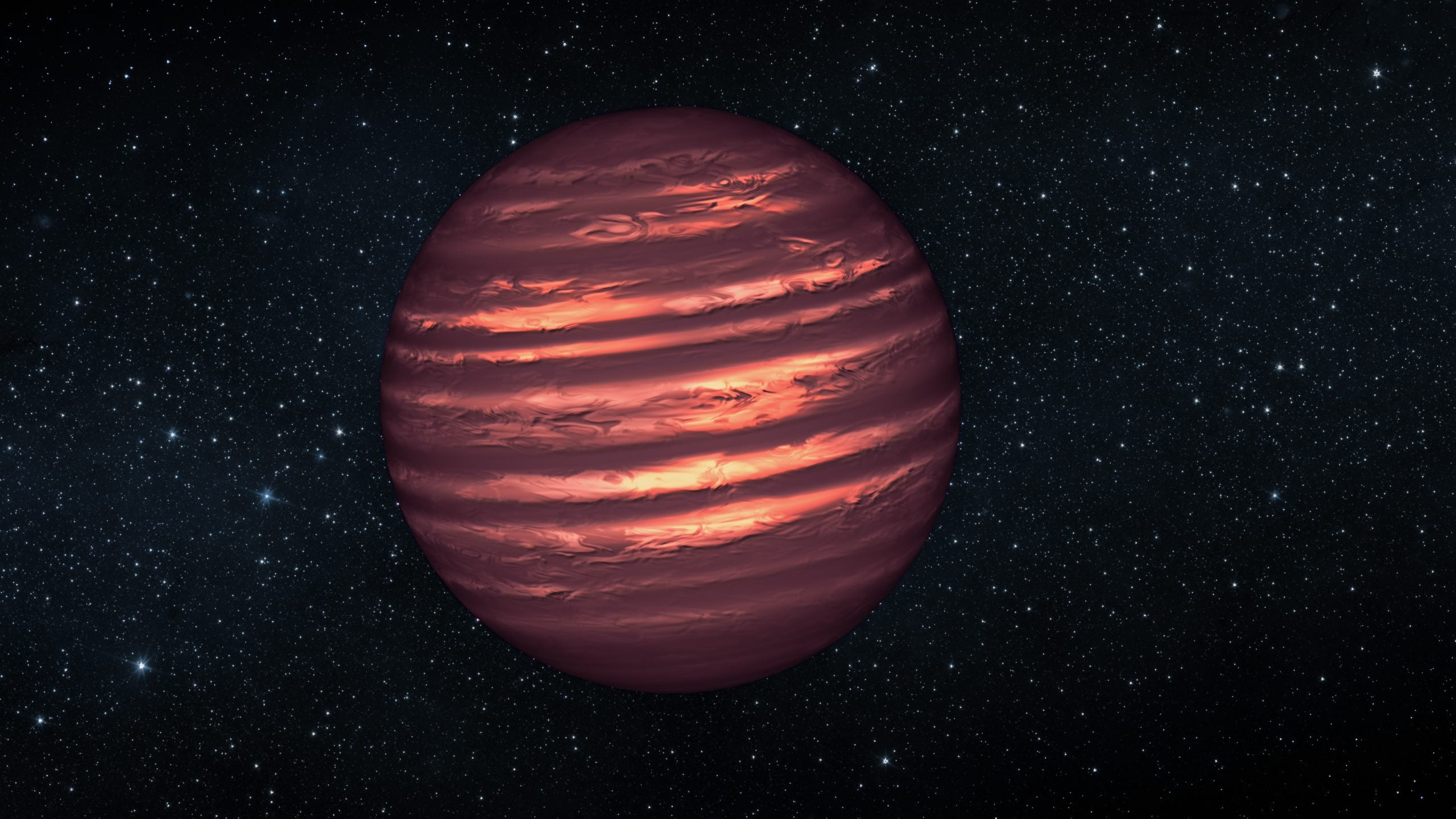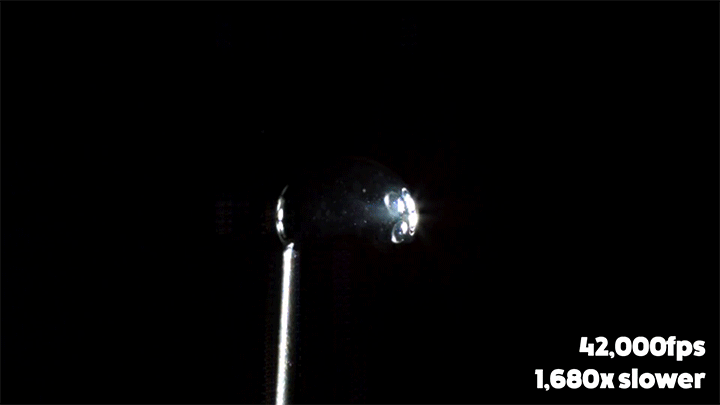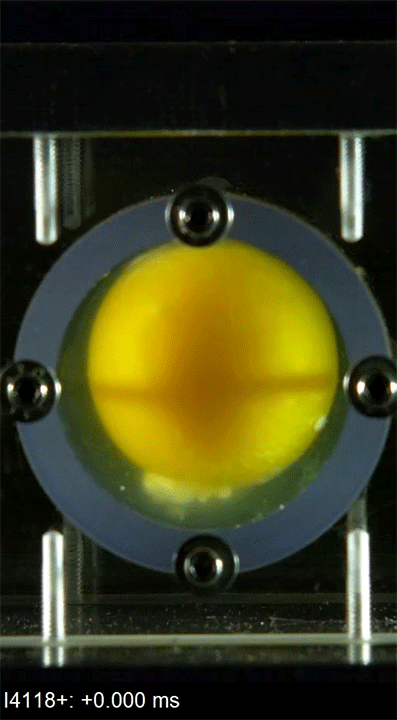In Thomas Blanchard’s “Mini Planets” oil-coated paint droplets swirl on colorful backgrounds. With band-like streaks, they truly do look like miniature planets rotating. I love that a few of them even have distinctive vortices! (Image and video credit: T. Blanchard)
Month: February 2021

When Honey Flows Faster Than Water
With its high viscosity, no one would ever pick honey to beat water in a race. But a new study shows there’s at least one circumstance where honey wins: inside a narrow, superhydrophobic tube with one or both ends closed. Inside these specially coated tubes a narrow cushion of air stays between the drop and the wall, reducing friction and increasing flow speed for both fluids.
But when one or both ends of the tube are blocked, the drops can only move when air squeezes past. In less viscous fluids, like water, the researchers found rapid internal flows inside the drop. These flows pressed the surface of the drop outward, reducing the air cushion and making it harder for air to squeeze past so that the drop could flow. In contrast, honey showed very little internal flow and so was able to flow through the tubes ten times faster than water! (Image and research credit: M. Vuckovac et al.; via Physics World; submitted by Kam-Yung Soh)

Brown Dwarfs and Their Stripes
Brown dwarfs are neither stars nor gas giants but something in between. Our two nearest brown dwarf neighbors are roughly equivalent to Jupiter in size but about 30 times more massive. Since these objects are so dim, little is known about their structure. Do they resemble stars in their atmospheric patterns or gas giants like Jupiter?
To find out, a team of researchers studied two nearby brown dwarfs with the Transiting Exoplanet Survey Satellite. They were able to map the objects’ varying lightcurves and model an upper atmosphere consistent with those observations. They found that both dwarfs have high-speed winds running parallel to their equators, meaning that they likely have stripes like Jupiter. The similarities even extended to the brown dwarfs’ poles, where — like on Jupiter — the atmosphere became dominated by local vortices. (Image credit: NASA/JPL; video credit: Steward Observatory; research credit: D. Apai et al.; via Gizmodo)

Ultrasonic Vibrations
Ultrafast vibrations can break up droplets, mix fluids, and even tear voids in a liquid. Here, the Slow Mo Guys demonstrate each of these using an ultrasonic homogenizer, a piece of lab equipment capable of vibrating 30,000 times a second. At that speed generating cavitation bubbles is trivial, and the flow induced by that cavitation is well-suited to emulsifying otherwise immiscible liquids like oil and water. They also show how a lone droplet gets torn into many microdroplets, a process formally known as atomization. (Image and video credit: The Slow Mo Guys)

How Wombats Make Stackable Feces
Wombats are unique among the animal kingdom for their ability to produce cubic feces approximately the size and shape of dice. Researchers found that wombats accomplish this geometric feat thanks to the structure of their intestines, which have bands of differing stiffness that run the full length of their guts. When the intestines contract, the stiffer bands contract first, gradually shaping and sculpting the corners of the feces.
The results have implications both for manufacturing soft materials and for human health. One of the early effects of colon cancer is a stiffening of portions of the intestine; that means that doctors may be able to use changes in the shape of a patient’s feces as a warning sign for diagnosis. (Image and research credit: P. Yang et al.; video credit: Royal Society of Chemistry; via Gizmodo)

“Satellike”
When watching Roman De Giuli’s “Satellike,” you may think you’re looking at satellite imagery of Earth. In reality, each sequence is a combination of watery ink and dried paint on paper. You can see some behind-the-scenes glimpses of the process and the artworks that inspired the work here. (Image and video credit: R. De Giuli; submitted by Mark S.)

Microfluidic Pac-Man
Researchers are using coalescence to guide microdroplets through a miniature maze, a la Pac-Man. To steer the main droplet, they place a smaller droplet nearby in the direction they want to move. When the drops coalesce, it moves the main droplet in the target direction. By repeating the process, researchers can drive the drop through a maze or perform tasks like cleaning or transporting particles by picking them up. Learn more over at APS Physics. (Image and research credit: J. Chaaban et al.; via APS Physics)

Snowflake Velocimetry
In our era of remote learning, students don’t always have a chance to do hands-on lab experiments in the usual fashion. But that doesn’t mean they can’t explore important flow diagnostic techniques. Here a simple smartphone video of snow falling gets turned into a lesson on particle image velocimetry, or PIV, a major technique for measuring flow velocities.
A nearby house acts as a fixed backdrop, and by comparing snowflake positions from one frame to the next, students can measure the instantaneous flow patterns in the snowfall. Of course, that’s a tedious task to do by hand, but luckily there are computer programs that do it automatically. Simply run the smartphone video through the software, and analyze the patterns it reveals!
As a bonus, students don’t have to get distracted by the complexities of laser sheets and flow seeding that are normally a part of PIV. Instead, the flow and the lighting are already right outside their window, and they can concentrate instead on learning the principles of the technique and how to use the software. (Image and submission credit: J. Stafford)

This Is Your Brain
The human brain, like an egg, consists of soft matter bathed in a fluid and encased in a hard shell. To better understand how our brains respond to sudden accelerations, researchers looked at how egg yolks behave. In a purely translational impact (Image 1), the egg yolk deforms very little. But rotational motions (Images 2 and 3) cause major effects because of the imbalance between pressure forces outside the yolk’s membrane and the centrifugal forces within it. Rotational deceleration was particularly potent (Image 3).
The researchers’ findings are consistent with concussion research, which has shown that impacts with rotational acceleration/deceleration inside the skull are the most damaging. Based on the yolk’s deformation, such impacts likely stretch neurons and disturb their delicate network. (Image credit: cracked egg – K. Nielsen, others – J. Lang et al.; research credit: J. Lang et al.; via Physics World; submitted by Kam-Yung Soh)

Strings of Swirls
Von Karman vortex streets are the rows of alternating vortices shed off isolated objects interrupting a flow. Here, the volcanic peaks of Cabo Verde disrupt an atmospheric flow accustomed to an empty ocean. In a steady wind, air wraps around the volcanoes and detaches first on one side, creating a vortex, then from the other side, making a vortex of the opposite rotation. Although these structures are always present, we only see them when they stir up the cloud layer, leaving these strings of swirls for hundreds of kilometers behind the islands. (Image credit: L. Dauphin/NASA; via NASA Earth Observatory)























